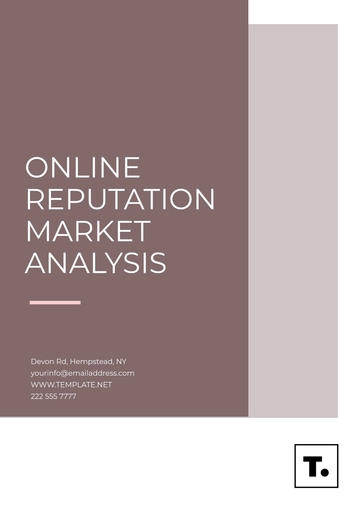Free Brand Investment Advertising Analysis Report

Executive Summary
This analysis report provides an overview of the brand investment strategies employed by [Your Company Name]. It examines the allocation of resources across various branding initiatives, the return on investment (ROI) from these endeavors, and the overall impact on the company's market position and brand equity.
Brand Investment Overview
This section delves into the specifics of brand investment by [Your Company Name], offering a detailed view of our financial allocations in various branding initiatives. The purpose is to analyze the distribution of funds across different branding areas, understanding their relative importance and anticipated impact on the company's overall brand strategy. The following data provides a comprehensive breakdown of the investments:
Branding Area | Investment | Percentage of Total Budget |
Digital Marketing | $600,000 | 30% |
Traditional Advertising | $400,000 | 20% |
Social Media Campaigns | $350,000 | 17.5% |
Content Creation | $300,000 | 15% |
Brand Partnerships | $200,000 | 10% |
Research and Development | $150,000 | 7.5% |
Corporate Social Responsibility | $100,000 | 5% |
Employee Training | $100,000 | 5% |
Strategic Importance:
Digital Marketing: Digital marketing is pivotal for effectively engaging with audiences who primarily interact with brands online. It encompasses a range of tactics from SEO to digital ads, crucial for maximizing visibility on digital platforms and driving targeted traffic.
Traditional Advertising: Despite the digital shift, traditional advertising remains crucial for reaching segments of the audience not fully immersed in the digital world. It provides a broad and diverse reach, essential for comprehensive market coverage and reinforcing brand presence across various demographics.
Social Media Campaigns: Social media is a dynamic platform for interactive and personal brand engagements. These campaigns are crucial for building brand personality, fostering community, and facilitating immediate dialogue with customers, enhancing brand loyalty and advocacy.
Content Creation: High-quality, informative content is key to establishing [Your Company Name] as a thought leader in the advertising industry. It's essential for engaging audiences with insightful and value-added content, thereby driving brand credibility and trust.
Brand Partnerships: Collaborations and partnerships play a significant role in enhancing brand exposure and tapping into new customer bases. They are instrumental in cross-promotional efforts, driving mutual growth and expanding market reach.
Research and Development: Crucial for innovation in branding strategies and staying ahead of market trends.
Corporate Social Responsibility: Investment in R&D is critical for staying at the forefront of industry innovations and trends. It enables the development of cutting-edge advertising solutions, keeping the brand relevant and competitive.
Employee Training: CSR initiatives contribute significantly to the brand's ethical image and public perception. While the direct financial ROI may be less apparent, CSR activities play a key role in building a responsible brand image, essential in today’s socially-conscious market.
Investment Insights:
Digital Marketing: Receives the highest allocation due to its direct impact on reaching and engaging with the contemporary, online audience. It includes online advertising, SEO, and digital campaigns.
Traditional Advertising: While traditional media has a lower relative budget, it remains crucial for comprehensive market coverage and reaching segments less active online.
Social Media Campaigns: Increased investment reflects the growing importance of social media in brand communication and consumer engagement.
Content Creation: Aligned with the trend towards value-driven marketing, investment in content creation is key for brand positioning as an industry thought leader.
Brand Partnerships: Collaborations with other brands and influencers offer mutual benefits and expand market reach.
Research and Development: Ensures the brand stays innovative and adaptable to emerging trends and technologies.
Corporate Social Responsibility and Employee Training: Though these areas have lower budget allocations, they are integral to the company's ethical standing and internal capability building, respectively.
This overview of brand investment underscores our commitment to a strategic approach to strengthening our brand presence. Each area of investment is carefully chosen to align with our objectives, ensuring a cohesive and impactful brand strategy.
Return on Investment
In this section, we examine the Return on Investment (ROI) for each branding area in [Your Company Name]'s investment portfolio. An analysis of ROI is crucial to evaluate the effectiveness of our brand investments, ensuring optimal allocation of resources and strategic decision-making.
Branding Area | Estimated ROI | ROI Percentage |
Digital Marketing | $1,800,000 | 300% |
Traditional Advertising | $560,000 | 140% |
Social Media Campaigns | $875,000 | 250% |
Content Creation | $450,000 | 150% |
Brand Partnerships | $340,000 | 170% |
Research and Development | $240,000 | 160% |
Corporate Social Responsibility | $130,000 | 130% |
Employee Training | $115,000 | 115% |
Qualitative Impact:
Digital Marketing: A substantial increase in online visibility and interactive engagement with customers. Effective in driving tailored marketing campaigns and fostering customer-centric experiences.
Traditional Advertising: Extends reach to wider and more varied demographics, reinforcing brand presence in the collective consciousness. Instrumental in maintaining brand consistency across diverse media channels.
Social Media Campaigns: Drives significant audience interaction, cultivating a loyal community around the brand. Effective in personifying the brand and enhancing customer relationships.
Content Creation: Bolsters the brand's authority and credibility through informative and engaging content. A key driver in attracting organic reach and establishing thought leadership.
Brand Partnerships: Facilitates broadened market exposure and access to new customer segments through strategic alliances. Offers synergistic opportunities for co-branding and shared marketing initiatives.
Research and Development: Enables the brand to stay at the forefront of innovation, adopting cutting-edge marketing tactics and staying responsive to market changes.
Corporate Social Responsibility: Significantly boosts the brand's social image and aligns with contemporary consumer expectations of corporate ethics and responsibility.
Employee Training: Enhances the skill set of the workforce, leading to improved service quality and innovation in client solutions.
ROI Summary:
Digital Marketing: The highest ROI, reflecting the effectiveness and efficiency of digital channels in today's market.
Traditional Advertising: Despite a lower ROI compared to digital marketing, it's crucial for a comprehensive brand presence and reaching diverse market segments.
Social Media Campaigns: Significant ROI and qualitative benefits like improved customer loyalty and brand engagement.
Content Creation: Solid ROI with added benefits of establishing the brand as a thought leader and attracting organic traffic.
Brand Partnerships: Good ROI with the added advantage of tapping into new audiences and collaborative marketing.
Research and Development: Vital for maintaining a competitive edge through innovative strategies and adaptive marketing practices.
Corporate Social Responsibility: While offering a lower financial ROI, it significantly contributes to a positive brand image and aligns with modern consumer values.
Employee Training: Essential for sustaining high-quality service and brand reputation, which indirectly benefits overall brand performance.
This analysis underscores the multi-dimensional benefits of [Your Company Name]'s branding investments, balancing financial returns with qualitative impacts. It demonstrates our commitment to strategic investment that yields financial benefits.
Market Impact and Brand Equity
This section focuses on assessing the impact of [Your Company Name]'s brand investments on its market presence and brand equity. Evaluating these aspects is crucial to understanding how our branding efforts translate into tangible market performance and perceived brand value. The following analysis provides an in-depth look at various metrics before and after our strategic brand investments:
Metric | Pre-Investment Value | Post-Investment Value |
Brand Awareness | 40% | 70% |
Market Share | 15% | 22% |
Customer Loyalty Index | 70% | 90% |
Brand Perception Score | 6/10 | 9/10 |
Employee Engagement | 65% | 85% |
Social Media Engagement | 50,000 interactions | 150,000 interactions |
Brand Equity Indicators:
Brand Awareness: A significant increase in brand awareness reflects successful reach and engagement strategies, particularly through digital and social media marketing efforts.
Market Share: The notable rise in market share indicates effective market penetration and competitive positioning as a result of our branding and advertising campaigns.
Customer Loyalty Index: Improvement in customer loyalty highlights the effectiveness of targeted marketing and customer engagement strategies, enhancing customer retention and satisfaction.
Brand Perception Score: A substantial increase in this score demonstrates improved public perception, influenced by high-quality content, effective CSR initiatives, and overall brand presentation.
Employee Engagement: Higher employee engagement suggests effective internal branding and employee training, which contributes to better service quality and brand representation.
Social Media Engagement: The dramatic increase in social media interactions signifies successful engagement strategies and content resonance with our target audience.
The market impact and brand equity analysis for [Your Company Name] reveal that our strategic brand investments have led to significant improvements in key performance indicators. These results underscore the effectiveness of our multi-faceted approach to brand building, encompassing digital transformation, content excellence, and robust customer engagement.
Branding Strategies and Innovation
Following the analysis of [Your Company Name]'s current brand investments and their impact on market presence and brand equity, this section outlines our future branding strategies and innovation plans. These strategies are designed to sustain and enhance the growth trajectory, adapting to emerging market trends and evolving consumer preferences.
Leveraging Emerging Technologies: To integrate advanced technologies like AI and machine learning in advertising strategies, offering personalized and predictive advertising solutions.
Expanding Global Reach: To extend our market presence internationally, focusing on untapped markets with potential high growth.
Sustainability-Driven Marketing: To adopt and promote sustainable marketing practices, aligning with the growing global emphasis on environmental responsibility.
Data-Driven Decision Making: To invest in advanced data analytics tools for deeper insights into consumer behavior and market trends.
Enhancing Digital Customer Experiences: To develop interactive and immersive digital experiences, utilizing AR/VR technologies in advertising campaigns.
Building Community and Loyalty Programs: To create and nurture online communities around the brand and implement loyalty programs to enhance customer retention.
Customized and Adaptive Content: To focus on creating highly customized content that adapts to the evolving needs and preferences of the target audience.
These branding strategies and innovation plans represent [Your Company Name]'s commitment to continuous growth and adaptation in the advertising industry. By embracing new technologies, expanding our global footprint, and prioritizing sustainable and customer-centric approaches, we aim to not only enhance our market position but also to contribute positively to the industry and society at large.
Conclusion
The brand investment strategy of [Your Company Name] has yielded substantial returns, not only in terms of financial ROI but also in enhancing brand equity and market position. The strategic allocation of funds across diverse branding areas has been effective in achieving targeted objectives, with digital marketing emerging as the most profitable area. Moving forward, it is recommended to continue investing in high-ROI areas while also exploring new opportunities to sustain and grow [Your Company Name]'s brand presence in the market.
- 100% Customizable, free editor
- Access 1 Million+ Templates, photo’s & graphics
- Download or share as a template
- Click and replace photos, graphics, text, backgrounds
- Resize, crop, AI write & more
- Access advanced editor
Discover the Brand Investment Advertising Analysis Report Template from Template.net, your key to unlocking ROI insights with precision. This editable and customizable report empowers strategic decision-making by dissecting investment performance. Craft actionable strategies effortlessly using our Ai Editor Tool, ensuring your brand investments yield maximum returns in the dynamic marketplace.





























